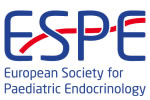hrp0084p2-472 | Growth | ESPE2015
Characterisation of Partial SHOX Deletions/Duplications Reveals Intron 3 to be a Hotspot Region
Benito-Sanz Sara , Belinchon Alberta , Heath Karen E
hrp0094p2-234 | Fetal, neonatal endocrinology and metabolism (to include hypoglycaemia) | ESPE2021
Continuous Glucose Monitoring (CGM) Reveals Undertreated Hypoglycemia in Patients with Congenital Hyperinsulinism
Hood Davelyn E. , Roberts Brian K. , Neale Ann , Raskin Julie ,
hrp0095p1-333 | Multisystem Endocrine Disorders | ESPE2022
Emerging phenotypes linked to variants in SAMD9 and MIRAGE syndrome
P. Suntharalingham Jenifer , Ishida Miho , E. Stalman Susanne , Solanky Nita , E. Moore Gudrun , C. Achermann John , Buonocore Federica
hrp0082fc6.3 | Gonads & DSD | ESPE2014
LRH1 Rescues SF1 Deficiency for Steroidogenesis in vitro but Cannot Explain the Broad Phenotype of SF1 Deficiency in men
Camats Nuria , Fernandez-Cancio Monica , Audi Laura , Andaluz Pilar , Mullis Primus E , Carrascosa Antonio , Fluck Christa E
hrp0089rfc1.1 | Adrenals & HPA Axis | ESPE2018
The Relative Contributions of Genetic and Environmental Factors on Cortisol Metabolism at Pre-, Mid- and Post-Pubertal Ages
van Keulen Britt , Dolan Conor , Andrew Ruth , Walker Brian , Boomsma Dorret , Rotteveel Joost , Finken Martijn
hrp0092fc5.4 | Thyroid | ESPE2019
Thyroid Dysgenesis: Exome-Wide Analysis Identifies Rare Variants in Genes Involved in Thyroid Development and Cancer
Larrivée-Vanier Stéphanie , Jean-Louis Martineau , Magne Fabien , Bui Helen , Samuels Mark E. , Polak Michel , Van Vliet Guy , Deladoëy Johnny
hrp0094fc5.4 | Sex Development and Gender Incongruence | ESPE2021
Reproductive hormone levels in Minipuberty as a predictor of Testicular Endocrine Function and Penile Length in Healthy Young Men: An 18-year longitudinal Cohort Study
Henriksen Louise S. , Petersen Jorgen H. , Skakkebaek Niels E. , Jorgensen Niels , Virtanen Helena E. , Juul Anders , Toppari Jorma , Main Katharina M. ,
hrp0097p1-554 | Pituitary, Neuroendocrinology and Puberty | ESPE2023
The Evaluation of Cranial Magnetic Resonance Images of Rapidly Progressive Early Puberty Cases
Kilinç Uğurlu Aylin , Özdem&idot;r Gökçe Ayse , Çakir Gündoğan Seçil , Seçil EkşİOğlu Ayşe , Boyraz
Mehmethrp0089p1-p156 | GH & IGFs P1 | ESPE2018
The Effect of Growth Hormone Treatment in Children after Hematopoietic Stem Cell Transplantation
Hoekx CA , Bresters D , Le Cessie S , Scholte C , Oostdijk W , Hannema SE
hrp0095p1-315 | Growth and Syndromes | ESPE2022
A Novel PADI6 Variant as a Cause of Recurrent Miscarriage and Multi Locus Imprinting Disturbance within the same family
Stern Eve , Goldman Shira , De Franco Elisa , E Flanagan Sarah , Pinhas-Hamiel Orit , Regev Miriam



